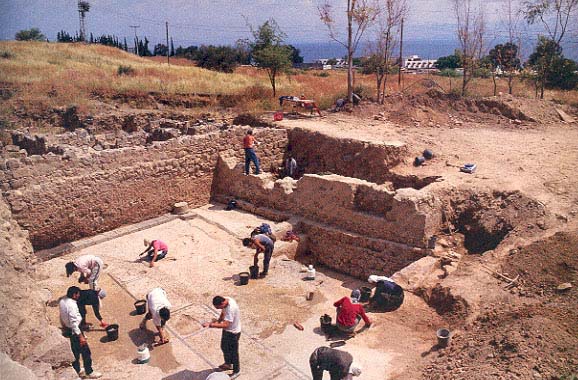The study house of a great sage? Three layers of history are embedded in this edifice, first discovered by excavator Hirschfeld during a brief salvage excavation in 1989. Seen here is the second of three layers, when it was a large public building. Built about 200 C.E. and in use until the mid-eighth century–the centuries when Tiberias flourished as a city of Jewish learning and piety–the building may have been the
Beth Midrash (house of study) of Rabbi Yohanan. The greatest sage of Tiberias, Rabbi Yohanan was the prime contributor to the Palestinian Talmud, completed in Tiberias at the end of the fourth century. This building has been preserved to a height of nearly 7 feet. Its 2-foot-thick ashlar walls have been exposed to a length of 35 feet so far. The floor of the large hall, consisting of a white stone mosaic pavement, was decorated with geometric shapes. A stylobate (stone foundation) supported a row of columns; the columns in turn supported the ceiling. In a corner of the hall floor, three stairs led down to a 10- by 13-foot mosaic-paved bath; it may have been a
miqveh, or Jewish ritual bath.
Above the study hall was a house dating to the ninth to eleventh centuries. Built of basalt and preserved to a height of more than 6 feet, it measured 30 by 13 feet and boasted an outdoor courtyard, a protective wall and a staircase. The ground floor contained two storage rooms, while the second-story living quarters held a mosaic floor–the first mosaic floor found in a private home of this period.
The earliest stratum–found below the study hall–dates to the first and second centuries C.E., based on a rich find of datable potsherds. Interestingly, one find, a fragment of a large stone jar, matches hundreds like it uncovered in excavations in the Upper City of Jerusalem. Stone vessels were especially favored by Jews because they could not become ritually impure, unlike their wood, pottery or glass counterparts. See photograph of a small figurine found in this earliest stratum.

